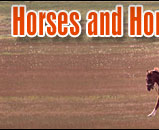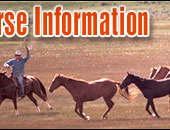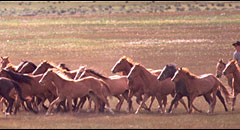 |
   |
|
|
|
You are here: Horses > Horse breeding > Horse Foaling |
Foaling, Foal Births, and Pregnant Mares: What to Expect
Three hundred days sounds like such a long time. When you
first discover that one of your mares is pregnant, you’re
sure you’ll have time to read all the books and watch the
foaling videos and have the veterinarian answer all your
questions. |
|
|
It still seemed like you had plenty of time when she
received her rhinopneumonitis vaccine in her fifth month and
the veterinarian started discussing how to improve her
nutrition during the last two trimesters. The time passed quickly, and suddenly the seventh and ninth
month vaccinations had passed. Perhaps you weren’t quite
finished with the foaling stall, but at least you still had
plenty of time to read all that information about foaling
and predicting labor. |
But now that winter is here, those three hundred days seem
to have flown by. Most owners expecting their first foal
tend to get a little nervous as the big event nears. This is
normal, and it’s probably close to how your mare feels, too.
Taking the time now to read up on abnormal foaling and labor
predictors can help boost your confidence and let you and
your mare enjoy this new experience.
Mares, like humans, are individuals, and each will react to
the approach of foaling in her own way. Mares tend to behave
similarly from year to year, so keeping track of how long
your mare’s gestation was may help to predict her next
foaling. Mares that have not foaled before (maiden mares)
can foal a bit early or late. Also, mares that are nervous
or high-strung can prolong gestation by resisting the normal
process of delivery. When attempting to predict foaling
dates, use the breeding dates, any history of the mare’s
previous gestations and your veterinarian’s input to
estimate.
Most mares will begin to “bag up” in the last month to month
and a half of gestation. This means that her udder will
begin to swell. Many mares will resist attempts to touch
their udders or nipples, which can interfere with the foal’s
nursing attempts. By helping your mare become accustomed to
having her teats handled or cleaned with a warm cloth, it
can help the foal to nurse after birth. Patience, a helper,
and occasionally a tranquilizer are needed for this.
Once she is accustomed to having her udder and teats
handled, regular checks can reveal when the udder begins to
fill. This will first be felt near the belly, and then can
be discerned in the mammary glands and nipples. As the mare
gets closer to foaling, her nipples will thicken, hang down
lower, and begin to develop a thick, waxy material. When the
nipples “wax,” it is a fairly reliable indicator that the
foal will be born within the next day or so.
Still, none of these indicators are absolute. Remember that
mares approach foaling in their own individual ways. Some do
not bag up at all, while others will produce copious amounts
of milk and may even leak milk for days before the foal is
born. Some mares will wax and others will not. Evaluate all
the signs as an overall indicator of impending foaling,
rather than relying on any one sign.
Other things to look for are signs of the rump and tailhead
muscles softening. This helps to prepare the pelvic area to
stretch during labor and foaling. The vulva may also become
swollen and elongated. Be aware of changes in the mare’s
behavior. This may indicate that foaling is imminent. Mares
who behave more or less affectionately than usual, try to
separate themselves from other horses, seem more nervous,
may be nearing the start of labor. Also, loss of appetite is
an indicator of approaching foaling. Foaling generally
occurs between 10pm and 4am, so if a mare that normally eats
well is uninterested in her dinner, she may be close to
delivery.
If you wish to videotape the delivery, you should help the
mare to become accustomed to the necessary light by leaving
the stall lights on for a week prior to the delivery. Mares
prefer to foal in a quiet, calm, dimly lit area.
Mares should foal on straw rather than bedding shavings.
This is because the shavings can stick to the mare’s vulva,
and can be drawn in as the mare struggles to push the foal
out. They can also adhere to the wet newborn foal and permit
bacteria to enter the umbilicus more easily. Dry, clean
straw is preferred, and the mare and foal can be switched to
shavings a few days after birth.
Most foals are born naturally, without human intervention.
If at all possible, allow this process to happen naturally
without attempting to help. The mare can usually deliver her
foal, clean it, and begin the bonding process without
assistance. Her owner should be nearby to help if needed,
but should quietly watch unless help is required. Owners who
are interested in early imprinting with the foal will still
have plenty of time to do this after the mare has had her
special time with her newborn.
Still, many owners worry they might not know when their
assistance is needed or wonder what to do if they do need to
help. The best idea is to formulate a foaling plan with your
veterinarian well before foaling is imminent. Foaling
usually lasts only an hour or so, so there is little extra
time to look up extra information if problems arise.
Be familiar with the foaling plan before the mare is near
foaling. Becoming familiar with the birth process can help
if you have to assist your mare via phone instruction until
the veterinarian arrives. Make sure that your vet has your
phone number, as well as good, clear directions to your
address and stable, with landmarks which are visible at
night. Also, remember that keeping your veterinarian’s
telephone numbers handy helps to prevent a panicked search
for it. Make sure that the telephone extension in the stable
works, or if you plan to use a cordless phone, that the
signal reaches the stable clearly.
Before foaling starts, there are some things you should do
to prepare. Wrap the mare’s tail and make sure the stable is
clean and lined with dry, fresh hay. Dim the lights if you
are not filming. Create a foaling kit and keep it well
stocked and close at hand. Make sure you’re familiar with
the normal foaling process and understand the points where
problems are most likely to arise. Also, know when you can
assist on your own and when you should call for help.
Foaling begins when the placental sac breaks, releasing a
gush of amniotic fluid. This is called “breaking water.” The
mare may lie down before this happens, and you will
sometimes see a smooth sac protrude between the mare’s
vulva. The pressure of the mare lying down usually ruptures
the sac. The fluid released when the mare’s water breaks
will lubricate the birth canal and the foal. The mare will
then lie on her side and begin to push.
Horses experience powerful contractions and will often groan
or vocalize as they push to expel the seventy to ninety
pounds of foal through the birth canal. As the mare pushes,
you will see another sac appear. This smooth, thin, clear or
white sac covers the foal, and you can see the foal within
it.
Normally, the foal’s front hooves are delivered first,
usually with one slightly ahead of the other. The hooves are
covered by a rubbery protective coating. The nose and head
should appear once the front legs are out to around the
knees.
This point is the first one where problems can occur. Help
should be sought if the mare strains for more than twenty
minutes without the feet appearing, if only one foot
appears, or if two feet appear but the head does not follow.
If the veterinarian is not far away and these conditions
occur, make the mare stand and walk. This will help the foal
to slide back into the mare’s womb and make repositioning
attempts easier. If the veterinarian cannot aid your mare
quickly, you may have to help her with directions over the
phone. You may need to wash and lubricate your arm to gently
slide it inside the mare’s birth canal. Generally, you will
follow the protruding leg until you find the foal’s chest,
and then you will be able to find the other leg, nose, or
head.
However, it is unusual that you will need to actually
attempt to reposition the foal. Most of the time, the only
help that is needed is to help to gently pull the foal out.
Normally, the most difficult part of the delivery is the
head and shoulders. The mare may rest briefly after the
shoulders are expelled. If she seems to be having trouble
getting the head, shoulders, or chest out, she may need you
to help her by gently pulling on the foal’s front feet.
You should use a dry towel to grasp the foal’s feet, as it
will be wet and slick. If the sac covering the foal has not
already broken, you should carefully break it at this time
with sharp scissors. Gently pull the foal’s front feet down
toward the mare’s hind hooves, not out—this helps to rotate
the foal’s head through the birth canal. Once the head and
shoulders have passed through the birth canal, pull straight
out along the line of the mare’s spine.
Again, if the mare seems to be struggling when the foal’s
hips are in the birth canal, the foal’s feet should again be
pulled gently down toward the mare’s hooves. This helps to
rotate the foal’s hips so they can pass through the birth
canal.
Whether the mare delivers naturally or the owner helps by
pulling, the foal’s rear feet will often remain in the birth
canal as the mare and the newborn foal rest. If you remove
the foal’s feet from the mare, make sure to leave the foal
close beside its mother. While the mare and foal rest, the
umbilical cord is still attached and transferring a large,
vital amount of blood from mare to foal. This five to
fifteen minute rest period is crucial.
After this rest period, the mare will stand and break the
umbilical cord. There is very little bleeding at this point.
Sometimes, the foal will stand too. If either stand or pull
away too early, the umbilical cord can snap prematurely.
This results in bleeding from both horses that must be
quickly controlled. Clamps, sutures, sterilized fishing
line, or even boiled shoelaces can be used to tie the ends
and stop the bleeding.
You should dip the foal’s navel in an iodine solution,
coating the umbilicus and sealing the tissue to prevent
infection. While seven percent iodine used to be the
solution of choice, recent research has shown that it may be
too harsh and may actually damage tissue, increasing the
risk of infection. Current guidelines recommend a diluted
Nolvasan mixture, which you can get from your veterinarian.
An easy way to accomplish this is to pour a small amount of
the solution into a syringe case or a small glass. Place
this over the umbilicus and press it against the foal’s
belly, then shake the container so that the entire stump is
well coated. Repeat this process two or three times a day
for the first forty-eight hours.
Foals can also be born in the breech position—hind-feet
first. This is not the normal foaling position, but it can
occur without complications. Breech births are more
difficult for the mare and it is more likely that help will
be needed than with a normal birth. You should call your
veterinarian as soon as you determine the foal is in the
breech position. You will likely not need to help your mare,
but it is better to notify the veterinarian and be aware of
what to do just in case.
In a breech delivery, you will see the hocks after the
hooves are delivered. You can also tell that the foal is
breech by the flexion of the foal’s hind feet. A foal’s
front feet will flex down toward the mare’s hooves, but in a
breech delivery, the hooves flex upward toward the mare’s
tail.
After the hocks are delivered, the foal’s hips and tail
follow. This is usually the hardest part of the delivery
because the hips are the foal’s widest portion when
delivered this way. Again, the owner may need to grasp the
foal’s feet and pull gently down toward the mare’s hooves to
rotate the foal’s pelvis so it can pass through the birth
canal.
Whether normal or breech, after the foal’s birth, the next
steps are the delivery of the placenta and the foal’s first
attempts to nurse.
Your first glimpse of the placenta will be a large mass of
red and white tissue protruding from the mare’s vulva. The
placenta should be delivered within two to four hours after
the foal is born. If it is retained much longer than that,
it can increase the risk of infection. Even if the rest of
the foaling proceeded normally, a retained placenta requires
veterinary help.
The foal should stand and begin to nurse within four to six
hours after birth. Most foals will accomplish this within
one hour. A newborn foal can be somewhat weak or have
difficulty standing—after all, they’ve never had to bear
their own weight before—and can also have a little trouble
latching on to the teat. You can gently help guide the foal
to the nipple, and your veterinarian can teach you some
tricks to make it easier to work with the newborn foal.
 |
Read the next horse breeding article on
Hand Raising a Foal. |
|
|
|
|
 |
|
|
 |
 |
  
Visit Equestrian Cupid now.
The best and largest equestrian club for meeting the other half for friendship and marriage
|
|
 |
|
|
|
Horse Education
|
|
|
|
|
Horse Information Topics
|
|
|
|
|
|
|
|
Horse Business Owners
|
| |
Advertise with Us
Have your horse products or services exposed to over 27,000 of our monthly visitors.
|
|
|
|
|
|